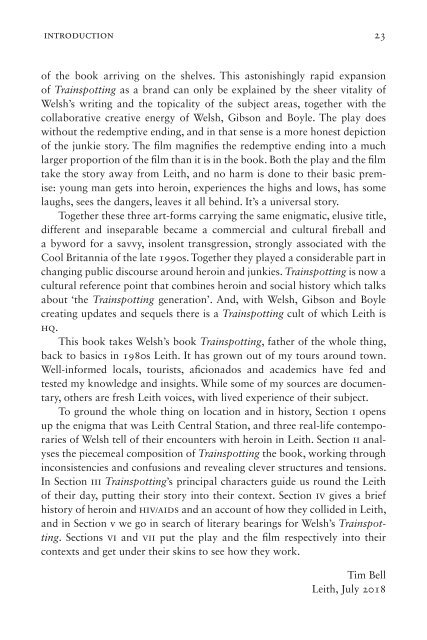Choose Life Choose Leith by Tim Bell sampler
By examining the book, the play and the film, Choose Life, Choose Leith both critically analyses the Trainspotting phenomenon in its various forms, and contextualises the importance of the location of Leith and the culture of 1980s Britain. Looking in detail at the history of Leith, the drug culture, the spread of HIV/AIDs, and how Trainspotting affected drug policy, Leith and the Scottish identity, the book highlights the importance of Trainspotting. Choose Life, Choose Leith acts as a reference book, a record of the times and a background as to the history that led to the real-life situation and the publication of the book.
By examining the book, the play and the film, Choose Life, Choose Leith both critically analyses the Trainspotting phenomenon in its various forms, and contextualises the importance of the location of Leith and the culture of 1980s Britain. Looking in detail at the history of Leith, the drug culture, the spread of HIV/AIDs, and how Trainspotting affected drug policy, Leith and the Scottish identity, the book highlights the importance of Trainspotting. Choose Life, Choose Leith acts as a reference book, a record of the times and a background as to the history that led to the real-life situation and the publication of the book.
You also want an ePaper? Increase the reach of your titles
YUMPU automatically turns print PDFs into web optimized ePapers that Google loves.
introduction 23<br />
of the book arriving on the shelves. This astonishingly rapid expansion<br />
of Trainspotting as a brand can only be explained <strong>by</strong> the sheer vitality of<br />
Welsh’s writing and the topicality of the subject areas, together with the<br />
collaborative creative energy of Welsh, Gibson and Boyle. The play does<br />
without the redemptive ending, and in that sense is a more honest depiction<br />
of the junkie story. The film magnifies the redemptive ending into a much<br />
larger proportion of the film than it is in the book. Both the play and the film<br />
take the story away from <strong>Leith</strong>, and no harm is done to their basic premise:<br />
young man gets into heroin, experiences the highs and lows, has some<br />
laughs, sees the dangers, leaves it all behind. It’s a universal story.<br />
Together these three art-forms carrying the same enigmatic, elusive title,<br />
different and inseparable became a commercial and cultural fireball and<br />
a <strong>by</strong>word for a savvy, insolent transgression, strongly associated with the<br />
Cool Britannia of the late 1990s. Together they played a considerable part in<br />
changing public discourse around heroin and junkies. Trainspotting is now a<br />
cultural reference point that combines heroin and social history which talks<br />
about ‘the Trainspotting generation’. And, with Welsh, Gibson and Boyle<br />
creating updates and sequels there is a Trainspotting cult of which <strong>Leith</strong> is<br />
hq.<br />
This book takes Welsh’s book Trainspotting, father of the whole thing,<br />
back to basics in 1980s <strong>Leith</strong>. It has grown out of my tours around town.<br />
Well-informed locals, tourists, aficionados and academics have fed and<br />
tested my knowledge and insights. While some of my sources are documentary,<br />
others are fresh <strong>Leith</strong> voices, with lived experience of their subject.<br />
To ground the whole thing on location and in history, Section i opens<br />
up the enigma that was <strong>Leith</strong> Central Station, and three real-life contemporaries<br />
of Welsh tell of their encounters with heroin in <strong>Leith</strong>. Section ii analyses<br />
the piecemeal composition of Trainspotting the book, working through<br />
inconsistencies and confusions and revealing clever structures and tensions.<br />
In Section iii Trainspotting’s principal characters guide us round the <strong>Leith</strong><br />
of their day, putting their story into their context. Section iv gives a brief<br />
history of heroin and hiv/aids and an account of how they collided in <strong>Leith</strong>,<br />
and in Section v we go in search of literary bearings for Welsh’s Trainspotting.<br />
Sections vi and vii put the play and the film respectively into their<br />
contexts and get under their skins to see how they work.<br />
<strong>Tim</strong> <strong>Bell</strong><br />
<strong>Leith</strong>, July 2018

















